Primary care – avoidable hospital admissions
This section presents data for the primary care indicators supplied by Australia to the OECD collection. It compares these data with the HCQO results for OECD countries and comments on the comparability of the data provided to the OECD specification (OECD 2021).
The OECD HCQOs for primary care include rates of avoidable hospital admissions for a range of conditions. Rates of avoidable hospital admissions serve as measures of the effectiveness of the primary health care system, as access to a high-performing primary care system can decrease acute deterioration and hospital admissions among people with the examined conditions (OECD 2021).
The OECD published all primary care indicators in OECD.Stat and a selection of primary care indicators in Health at a glance 2021. Australia calculated and submitted 6 of the primary care indicators requested:
- Asthma hospital admission rates
- Chronic obstructive pulmonary disease (COPD) hospital admission rates
- Congestive heart failure (CHF) hospital admission rates
- Hypertension hospital admission rates
- Diabetes hospital admission rates
- Diabetes lower extremity amputation rates.
The indicator definitions can be viewed here: Primary care indicator definitions
Overall data comparability and methods
The most recent data supplied by Australia for the acute care indicators was for 2018–19. These data are recorded as 2018 data in the OECD.Stat database, and so are described in that way here. Data from other OECD countries published on OECD.Stat for 2018 are used for comparison and calculation of OECD averages in this section. These data were extracted from the OECD.Stat database in November 2021, and may not reflect subsequent updates made to the database.
Primary care indicators were reported by the OECD for adults aged 15 and over, with rates age-sex standardised to the 2010 OECD population. The indicators are presented on the same basis here.
Health at a glance 2021 notes that disease prevalence and availability of hospital care, differences in coding practices, and differences in hospital data coverage may affect the comparability of the data (OECD 2021). To prevent double counting, countries were asked to exclude the transfer of patients between hospitals from the calculations for primary care indicators.
The counting unit in the NHMD is the separation which indicates the end of an episode of admitted patient care. Hence, Australia’s separation data are used in the calculation of hospital admission rates. Diagnosis and procedure codes are assigned after separation, when all information regarding the episode of care is available. This enables for more accurate capture of information.
Asthma hospital admission rate
Asthma is a common chronic condition that affects the airways (the breathing passage that carries air into our lungs).
In Australia, the asthma hospital admission rate reported for people aged 15 and over was 63 per 100,000 population in 2018 – an overall decrease from 70 per 100,000 population in 2011. The rate for females was higher than that for males (89 and 34 per 100,000 population, respectively).
Australia’s rate was higher than the OECD average of 38 asthma hospital admissions per 100,000 population. Mexico reported the lowest rate (6.9 per 100,000 population) based on estimation.
Interactive AA1.1 below compares OECD countries that submitted data for 2018 for this indicator, while AA1.2 presents Australia’s 10-year trend for this indicator where data are available.
AA1.1 presents OECD countries with data published for asthma hospital admission rate in 2018, which shows Australia had a higher rate than the OECD average. AA1.2 presents Australia’s 10-year trend for this indicator, which shows an overall decrease from 2011.
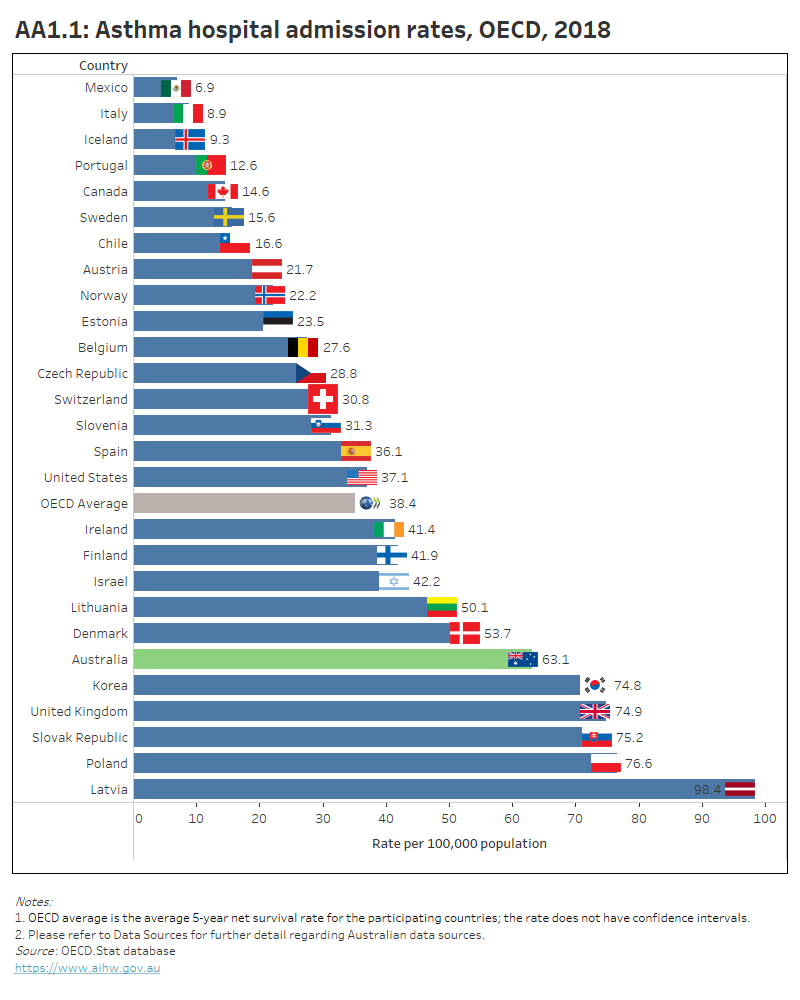
Refer to the data tables for more information.
Chronic obstructive pulmonary disease hospital admission rate
COPD is a preventable and treatable lung disease characterised by chronic obstruction of lung airflow that interferes with normal breathing and is not fully reversible.
In Australia, the COPD hospital admission rate reported for people aged 15 and over was 300 per 100,000 population in 2018 – an overall decrease from 317 per 100,000 population in 2011. The rate was higher for males than females (313 and 297 per 100,000 population, respectively) – a gap which has narrowed over the past decade.
Australia’s rate was higher than the OECD average of 177 per 100,000 population. Italy had the lowest rate (38 per 100,000 population).
Interactive AA2.1 below compares OECD countries that submitted data for 2018 for this indicator, while AA2.2 presents Australia’s 10-year trend for this indicator where data are available.
AA2.1 presents OECD countries with data published for COPD hospital admission rate in 2018, which shows Australia had a higher rate than the OECD average. AA2.2 presents Australia’s 10-year trend for this indicator, which shows an overall decrease from 2011.
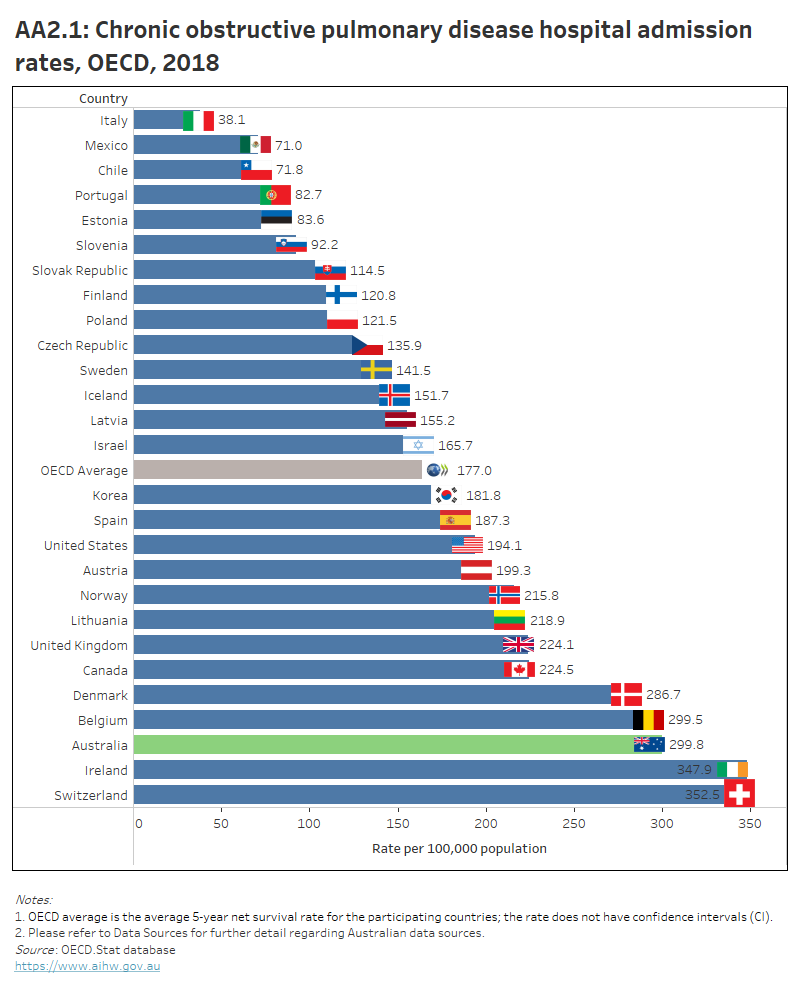
Refer to the data tables for more information.
Congestive heart failure hospital admission rate
CHF is a chronic condition in which the pumping power of the heart muscle is weakened.
In Australia, the CHF hospital admission rate reported for people aged 15 and over was 213.5 per 100,000 population in 2018. This rate has fluctuated over the past decade, ranging from 213 per 100,000 population in 2017 to 227 per 100,000 population in 2016. The rate was higher for males than females (256 and 184 per 100,000 population, respectively).
Australia’s rate was lower than the OECD average of 246 per 100,000 population. Mexico had the lowest rate (55 per 100,000 population) based on estimation.
Cardiac procedure codes were required for the calculation of the CHF hospital admission rate. The AIHW found that mapping was not straightforward in this instance as the ICD-9-CM codes supplied by the OECD did not map directly (in a one-to-one manner) to the ACHI code list used in Australia. The effect of this on the comparability of data are unknown.
Interactive AA3.1 below compares OECD countries that submitted data for 2018 for this indicator, while AA3.2 presents Australia’s 10-year trend for this indicator where data are available.
AA3.1 presents OECD countries with data published for CHF hospital admission rate in 2018, which shows Australia had a lower rate than the OECD average. AA3.2 presents Australia’s 10-year trend for this indicator, which shows a fluctuating trend over time.
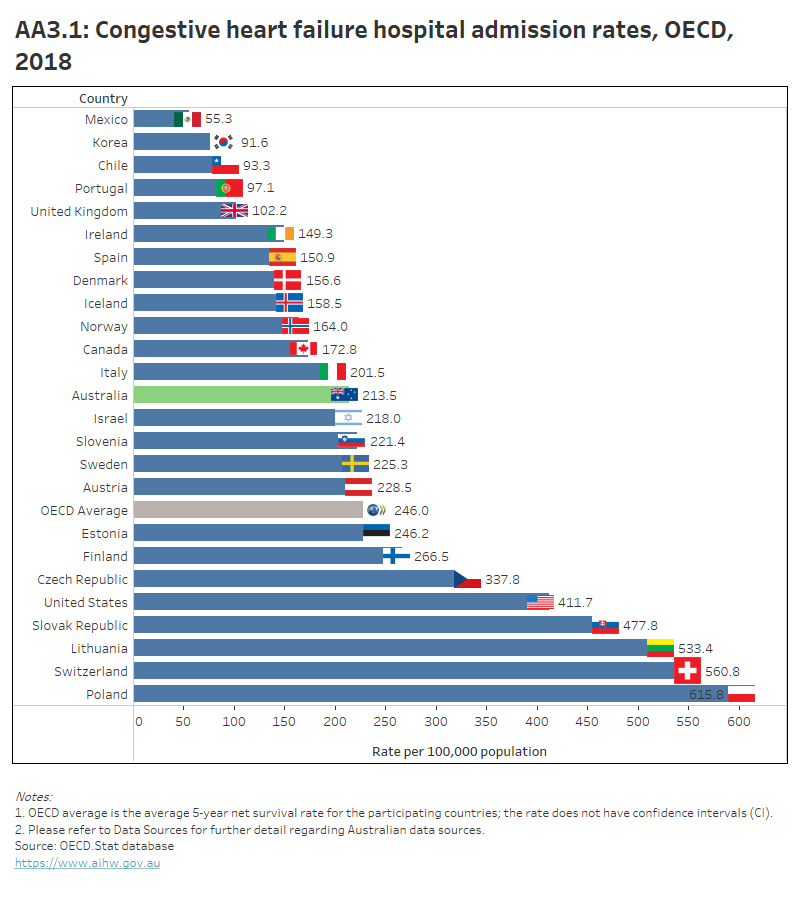
Refer to the data tables for more information.
Hypertension hospital admission rate
Hypertension, also known as high blood pressure, is a major risk factor for chronic conditions such as coronary heart disease and chronic kidney disease.
In Australia, the hypertension hospital admission rate reported for people aged 15 and over was 39 per 100,000 population in 2018, showing an overall increase from 36 per 100,000 population in 2011.The rate for females was higher than that for males (47 and 27 per 100,000 population, respectively).
Australia’s rate was lower than the OECD average of 69 per 100,000 population. Spain and Iceland had the lowest rates (6.4 and 7.8 per 100,000 population, respectively).
Cardiac procedure codes were required for the calculation of the hypertension hospital admission rate. The AIHW found that mapping was not straightforward in this instance as the ICD-9-CM codes supplied by the OECD did not map directly (in a one-to-one manner) to the ACHI code list used in Australia. The effect of this on the comparability of data are unknown.
Interactive AA4.1 below compares OECD countries that submitted data for 2018 for this indicator, while AA4.2 presents Australia’s 10-year trend for this indicator where data are available.
AA4.1 presents OECD countries with data published for hypertension hospital admission rate in 2018, which shows Australia had a lower rate than the OECD average. AA4.2 presents Australia’s 10-year trend for this indicator, which shows an overall increase over time.
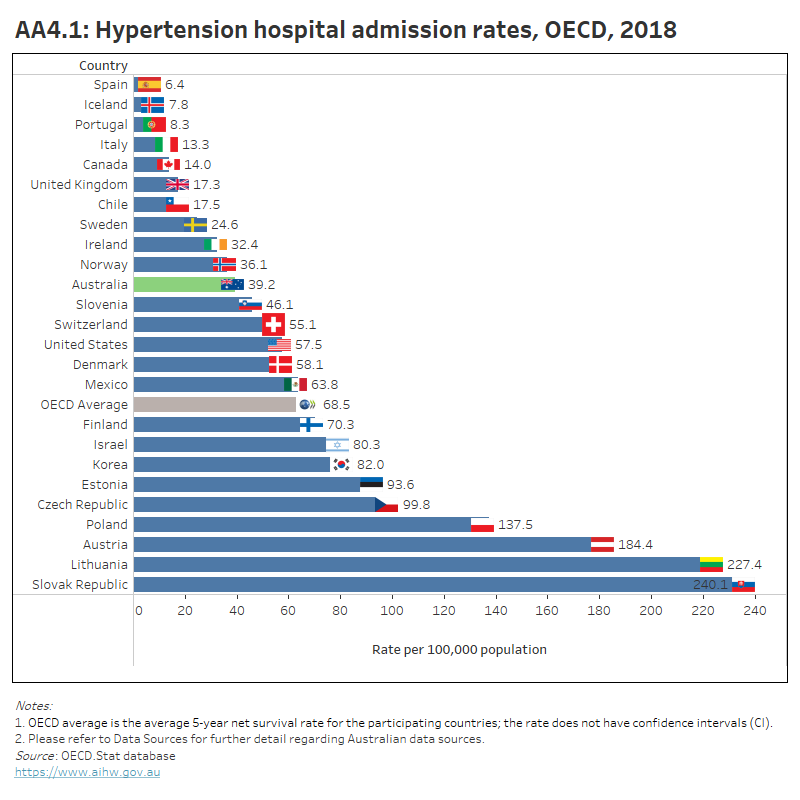
Refer to the data tables for more information.
Diabetes hospital admission rate
Diabetes is a chronic condition marked by high levels of glucose in the blood. Effective management of diabetes aims to maintain healthy blood glucose levels to prevent both short- and long-term complications, such as heart disease, kidney disease, blindness and lower limb amputation.
In Australia, the diabetes hospital admission rate reported for people aged 15 and over was 153 per 100,000 population in 2018, an increase from 136 per 100,000 population in 2013. The rate for males was higher than that for females (197 admissions and 118.5 admissions per 100,000 population respectively).
Australia’s rate was higher than the OECD average of 128 per 100,000 population. Iceland and Italy had the lowest rates (38 and 43 per 100,000 population).
It should be noted that changes to the Australian Coding Standards between 2009 and 2013 have affected the comparability of data reported over time for diabetes (NCCH 2008, NCCH 2010, NCCH 2013). The AIHW considers there is a break in series between 2009–10 and 2010–11 and therefore 2010 data are not presented. The AIHW also recommends that some caution should be taken when comparing data from before and after 2012 due to further changes in the coding standards relating to diabetes from 1 July 2012.
Interactive AA5.1 below compares OECD countries that submitted data for 2018 for this indicator, while AA5.2 presents Australia’s 10-year trend for this indicator where data are available.
AA5.1 presents OECD countries with data published for diabetes hospital admission rate in 2018, which shows Australia had a higher rate than the OECD average. AA5.2 presents Australia’s 10-year trend for this indicator, which shows a gradual increase since 2013.
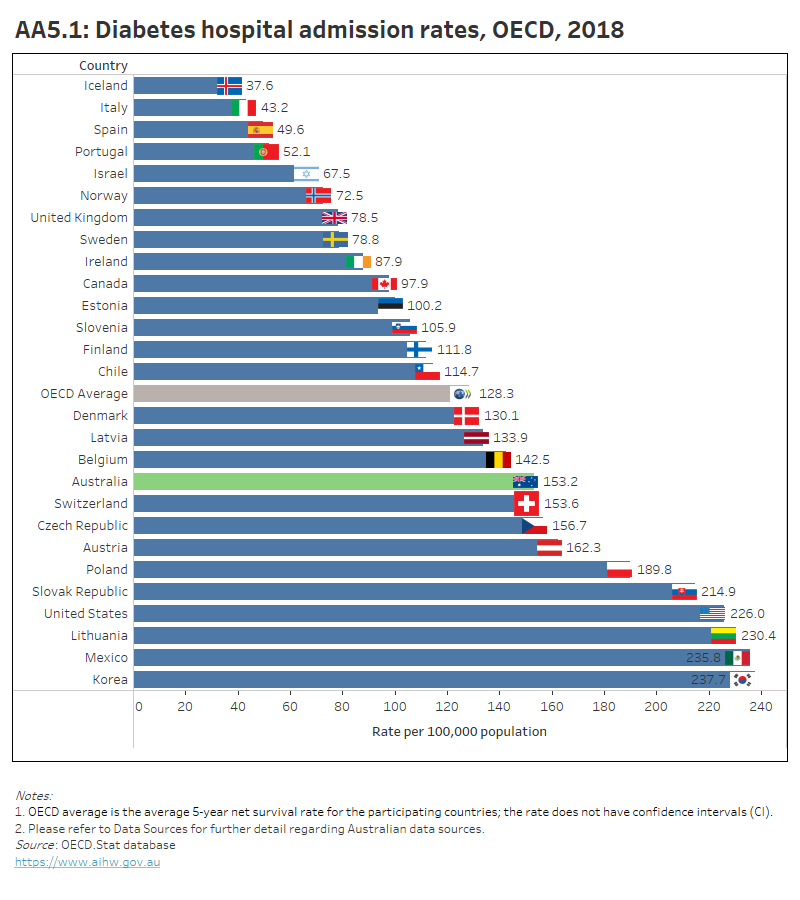
Refer to the data tables for more information.
Diabetes lower extremity amputation rate
Individuals with diabetes have a higher risk of lower limb amputation than people without diabetes (Narres et al. 2017).
In Australia, the rate for diabetes-related lower extremity amputation was 4.0 per 100,000 population in 2018. This rate has remained relatively stable since 2015. The rate for males was more than 3 times higher than that for females (6.2 and 2.0 per 100,000 population, respectively).
Australia’s rate was lower than the OECD average of 8.6 per 100,000 population. Iceland, Korea and Italy had the lowest rates (1.5, 2.4 and 2.5 per 100,000 population, respectively).
As outlined in the Diabetes hospital admission section, caution should be taken when comparing diabetes data because of changes to the Australian Coding Standards, which affected the recording of data relating to diabetes.
Interactive AA6.1 below compares OECD countries that submitted data for 2018 for this indicator, while AA6.2 presents Australia’s 10-year trend for this indicator where data are available.
AA6.1 presents OECD countries with data published for diabetes lower extremity amputation rate in 2018, which shows Australia had a lower rate than the OECD average. AA6.2 presents Australia’s 10-year trend for this indicator, which shows a stable trend since 2015.
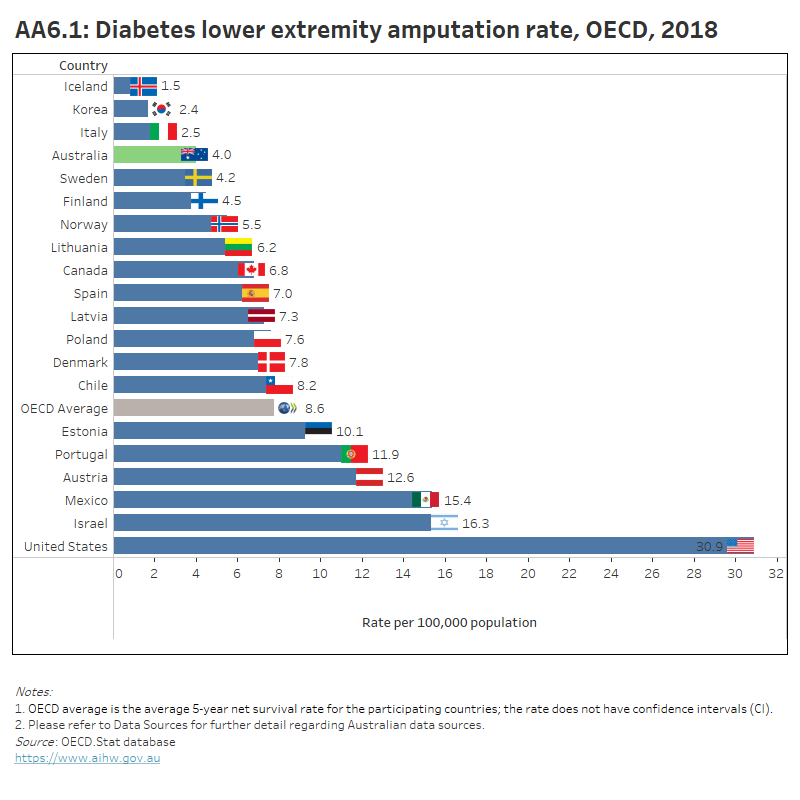
Refer to the data tables for more information.
Narres M, Kvitkina T, Claessen H et al. 2017. Incidence of lower extremity amputation in the diabetic compared with the non-diabetic population: a systematic review. PLoS One 12(8):e0182081.
National Centre for Classification in Health (NCCH) 2008. Australian Coding Standards for ICD-10-AM and ACHI, sixth edition. Sydney: NCCH.
NCCH 2010. Australian Coding Standards for ICD-10-AM and ACHI, seventh edition. Sydney: NCCH.
NCCH 2012. Australian Coding Standards for ICD-10-AM and ACHI, eighth edition. Sydney: NCCH.
OECD 2021. Health at a glance 2021: OECD indicators. Paris: OECD


